The State of Content Marketing in 2022

Heading into 2022, we wanted to learn more about content marketing trends—what challenges content marketers are facing, what’s working for them, and what’s not.
With that in mind, we launched a detailed survey to marketers around the world. More than 800 responded, and we published the results in our Content Matters 2022 Report.
There were five key trends that stood out to us:
- Content teams are often small, but budgets and teams are growing.
- Almost half of content marketers don’t understand how their content is performing.
- Seven in ten don’t have revenue goals tied to content.
- The majority of content strategy decisions come not from data but from ad hoc requests.
- Marketers show a strong preference for distributing their content on owned channels.
Small teams are being asked to do more with less, but many are flying blind. Let’s take a closer look.
Content teams are small.
We found that most content marketers work in teams of fewer than 10 people, even in larger organizations—but 80% of content marketers expect to create more content in the coming year.
The need for content continues to grow, but teams are struggling with a lack of people to produce it. However, these teams are growing—more than half of respondents noted their content teams have expanded over the past year.
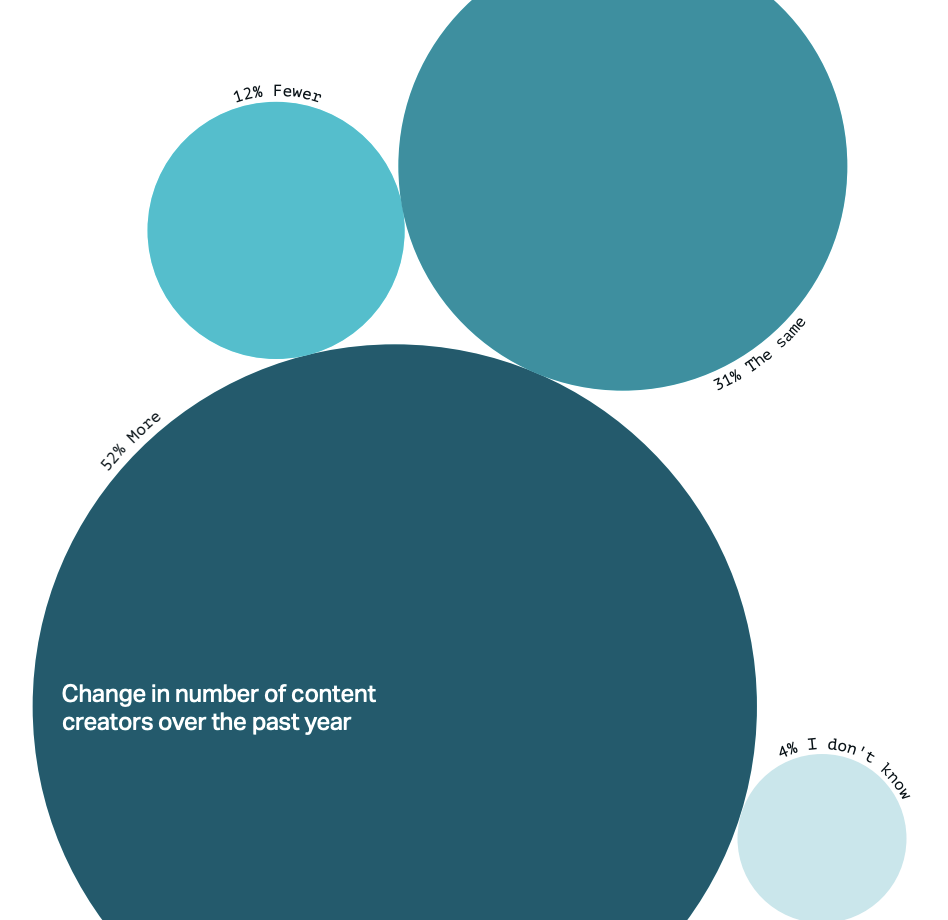
Content team’s budgets are growing too, but they’re being spent mainly on hiring more creators, not on technology.
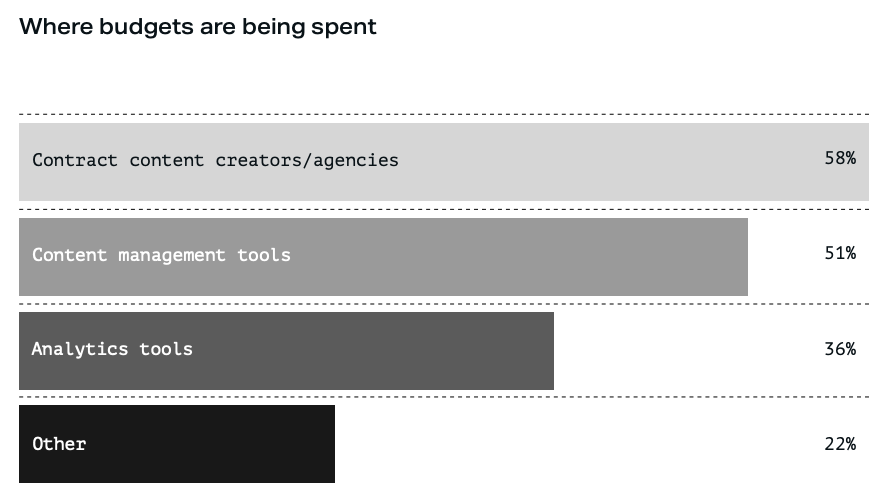
Our takeaway: With ever-present demands for more content, smaller content teams need to be able to create quickly, build on past success, and prove the impact of their work. That means using technology to help you get more out of less.
Using budget to hire more content creators is important, but investing in the right tools will allow you to speed up production time, identify and repurpose high-value content, and prove content ROI to build your case for more resources.
The gap in spending we see between hiring content creators and investing in technology speaks to the relative immaturity of content marketing as a whole. Going forward, we expect to see more investment in technology and less “throwing bodies at the problem.”
Almost half of content marketers don’t know how their content is performing.
When analyzing the performance of all this content that’s being created, half the marketers we surveyed are still in the dark. Most are relying on click-type metrics, leading them to make key content strategy decisions based on gut feel.
Forty-nine percent of our respondents said that they don’t understand how their content is really performing. Nine percent weren’t tracking metrics at all, 8% didn’t know if they were tracking metrics, and 32% said, “We’re tracking metrics, but we don’t know if those metrics are actually telling us what’s working.”
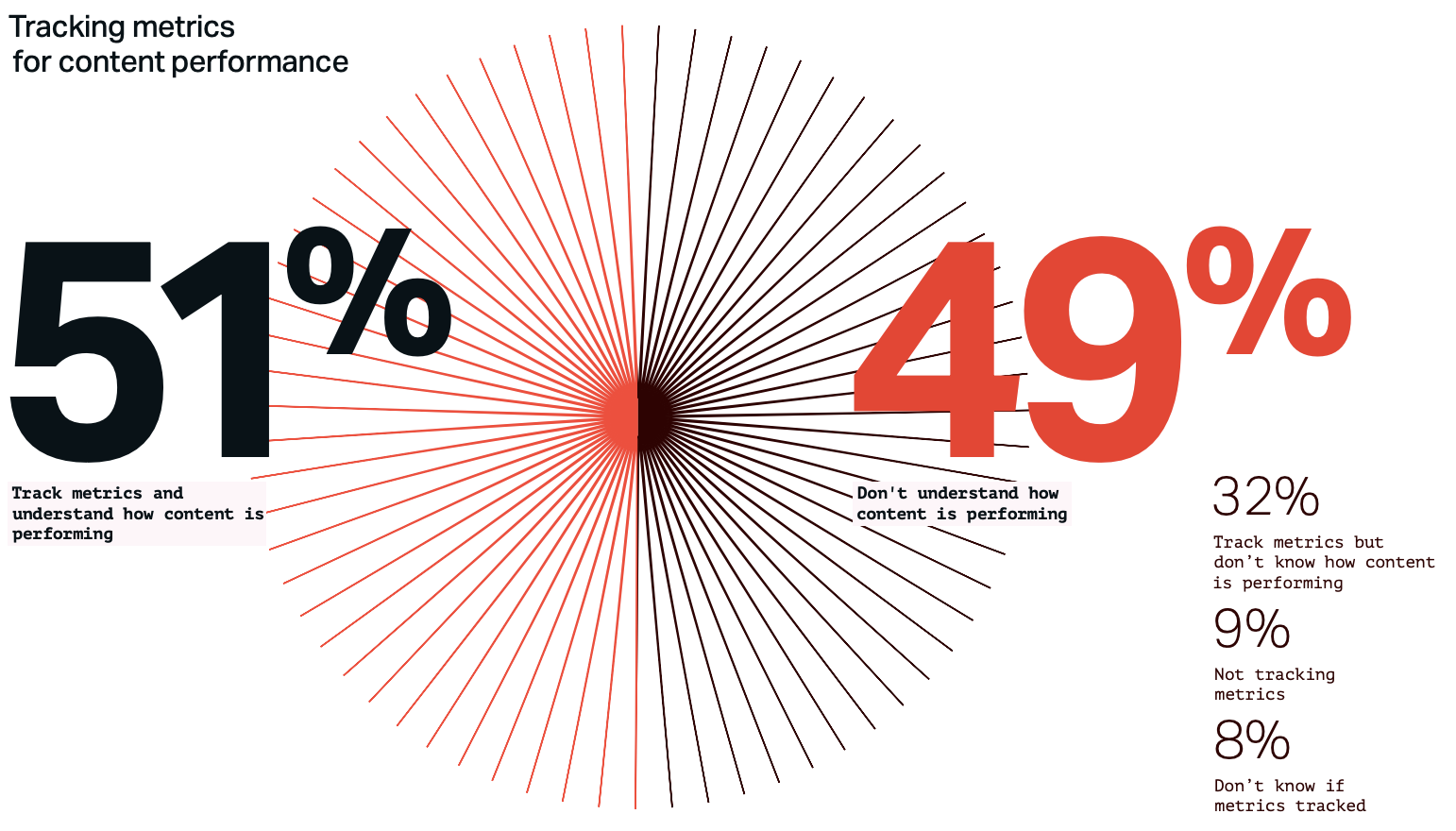
We also found that the No. 1 metric tracked by content marketers was page views, an indicator that prioritizes eyeballs over impact and doesn’t tell the full story of a customer’s lifecycle journey.
Our takeaway: What’s the reason for all of the confusion around content performance? Content teams aren’t investing enough in the right technology, and they’re forced to rely on surface-level vanity metrics or gut feel to guide their strategy.
Content marketers need tools that make it easy to determine the success of their content and optimize it for all stages of the customer journey. With legacy analytics tools like Google Analytics, this is a challenge. Purpose-built content analytics solutions, however, make it simple.
They help you understand what content is driving traffic, what content is most engaging, and, crucially, what content is inspiring users to take valuable conversion actions, like signing-up for your newsletter, requesting a demo, or buying your product.
53% of marketers don’t tie revenue goals to content.
Not only are content marketing teams struggling to measure the impact of their content, many aren’t planning with results in mind either. Fifty-three percent don’t have revenue goals tied to content, and another 20% don’t know if they do.
Only 27% of content marketers have specific revenue goals tied to content—with one in six unsure what the most effective revenue driver is for that content.
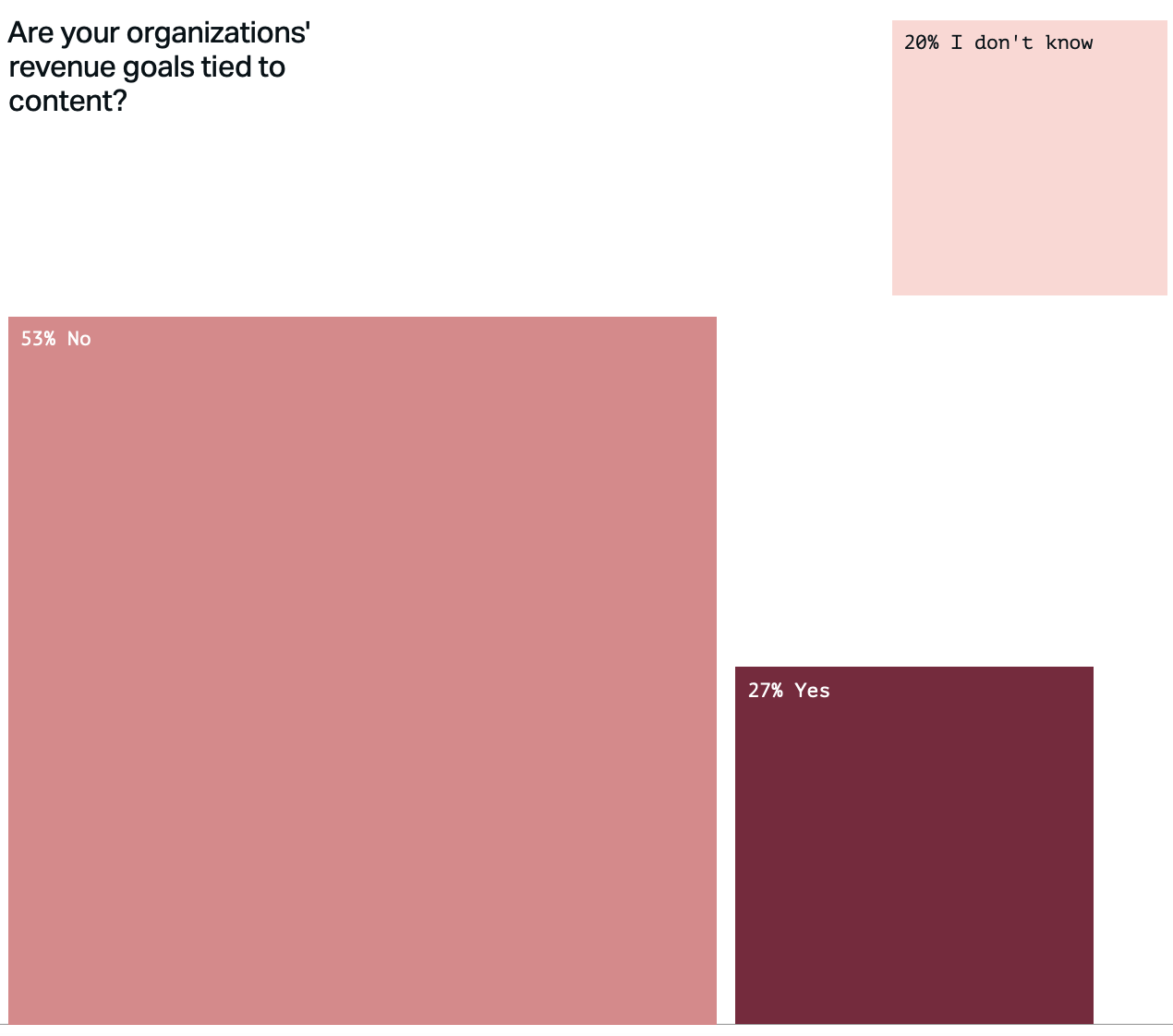
Despite these challenges, the need to use content to drive revenue is increasing. Almost 80% of respondents said they need to tie content more closely to revenue goals. That’s an overarching trend we saw throughout this survey. Marketers want to understand how their content is helping drive business goals and revenue, but they’re not there yet—53% can’t connect the two, 78% know they need to.
Our takeaway: Remember that 49% of respondents had no idea how their content was performing. Pair that with the fact that 53% of marketers don’t tie revenue goals to content, and you start to understand the problem. If you don’t know how your content is performing, all the way from creating awareness to generating ROI, how can you set and ultimately achieve revenue goals with content?
This comes back to technology. Needed are solutions that make it easy for content marketers to understand their direct impact on revenue and optimize their content strategy to align with business goals.
69% of content strategy decisions come not from data-driven analysis but from ad hoc requests.
With teams lacking a clear understanding of how their content performs, the majority of strategy decisions are being driven by requests from other teams. Content marketers are relying on guesswork and gut feel over content data and insights to decide what to create.
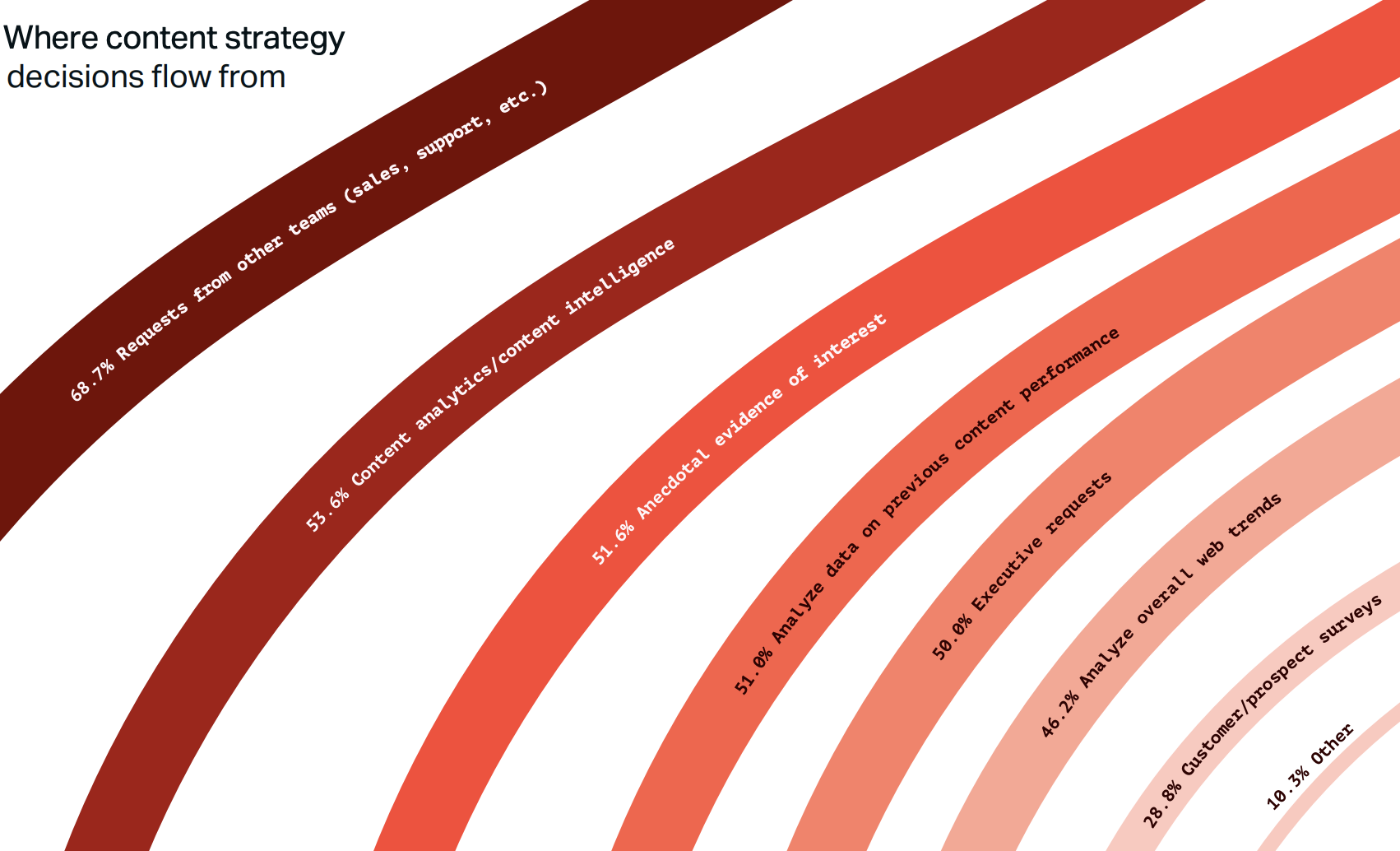
Our takeaway: Of course, you have to listen to others in your organization, but you can’t act in silos and ignore the data. Content insights represent your audience’s real quantitative feedback. Strategy decisions should always account for what your audience wants, so those insights must be your guiding light.
What if you’re not ignoring the data, but what’s available isn’t helping you make decisions? Again, this is an issue of needing purpose-built content analytics solutions that make it easy to understand the real value of your content throughout the customer journey.
Ad hoc content requests will continue to pop up, but to informedly prioritize, refine, or decline them, you need to be data-driven and stand by your expertise as content marketers.
Content is being distributed primarily on owned channels.
While both B2B and B2C respondents activate content across many channels (an average of four to seven for most), there is a strong preference across the board for distributing on owned channels. Content teams are mainly focused on creating content for their company website or blog, organic social media, and emails to their database.
Paid channels (social media and search ads) are still a focus for more than half of our respondents, though the choice of channels varies depending on company type. Most B2B respondents share posts and run ads on LinkedIn, while Facebook is the top paid and organic social channel for B2C.

Our takeaway: The preference toward owned channels is not surprising, given the imminent death of the third-party cookie. With advertisers now having a harder time with targeting and attribution, content creators need to find ways to move their audience to platforms that they can control—platforms where they get that first-party data. When you control first-party data, you can implement all kinds of monetization strategies.

Now more than ever, content is the most effective way for brands to connect with their customers. As humans, we get moved by stories, and the way we communicate stories online is through content. It’s the fuel for building relationships, informing buyers, and driving business results. Content matters.
To explore more content trends and insights to level up your content marketing this year, I invite you to dive into our Content Matters 2022 Report.